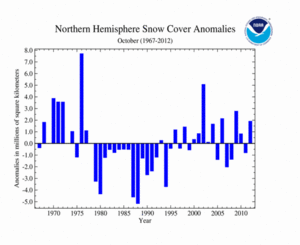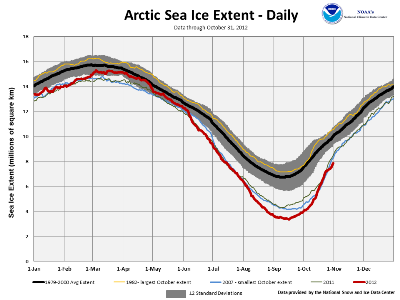NH Snow Cover Extent
Data were provided by the Global Snow Laboratory, Rutgers University. Period of record is 1967-2012 (45 years, no data availble for October 1969).
October marks the beginning of the cold season for the Northern Hemisphere and storms begin bringing snow to the higher latitudes and elevations. During October 2012, the Northern Hemisphere snow cover extent was 1.9 million square km (734,000 square miles) above the long-term average of 17.96 million square km (6.9 million square miles). This monthly value ranks as the eighth largest October snow cover extent in the 45-year period of record.
Across North America, snow cover extent for October 2012 was above average. Canada had much above average snow cover during the month, while the contiguous U.S. experienced below-average snow cover. The North American snow cover extent was 696,000 square km (269,000 square miles) above the long-term average of 8.1 million square km (3.1 million square miles). For the continent, above-average snow cover was observed across the Canadian Rockies and Prairies, while the U.S. Rockies and much of Alaska experienced below-average snow cover. For more information on the U.S. October 2012 snow events, please visit the U.S. October Snow/Ice Summary page.
Eurasian snow cover extent was also above average for October 2012, with a spatial extent of 11.1 million square km (4.3 million square miles), 1.2 million square km (463,000 square miles) above average. This was the 11th largest October snow cover extent on record for the continent. Above-average snow cover was observed for much of Russia and the Tibetan Plateau, while below-average snow cover was observed for the Himalayas.
Sea Ice Extent
According to the National Snow and Ice Data Center (NSIDC), the Northern Hemisphere sea ice extent — which is measured from passive microwave instruments onboard NOAA satellites — averaged for October 2012 was 7.00 million square km (2.70 million square miles). The monthly extent was 24.61 percent below average and ranked as the second smallest October Northern Hemisphere sea ice extent in the satellite record. The October 2012 Arctic sea ice extent was 230,000 square km (88,800 square miles) larger than the smallest October extent on record that occurred in 2007. Arctic sea ice rapidly expanded during October, after reaching an annual minimum in September, doubling in size between October 1st and 31st. October average Arctic sea ice has declined at a rate of 7.1 percent per decade.
According to analysis from the NSIDC, sea ice rapidly expanded into the East Siberian, Chukchi, and Laptev seas which were nearly completely frozen by the end of October. Conversely, the Kara, southern Beaufort, and Barents seas were much slower to freeze. The fast pace freezing of some regions of the Arctic was not enough to compensate for the slow freezing in other regions and make up the large ice extent deficits experienced during the late summer of 2012. At the end of October, Arctic sea ice extent continued to be much below average and near record-low levels.
The October 2012 Southern Hemisphere sea ice extent was 18.88 million square km (7.3 million square miles), 3.36 percent above average and the third largest October sea ice extent in the 1979-2012 period of record. Antarctic sea ice extent during October has increased at an average rate of 0.9 percent per decade, with substantial interannual variability.
For further information on the Northern and Southern Hemisphere snow and ice conditions, please visit the NSIDC News page.
 NOAA's National Centers for Environmental Information
NOAA's National Centers for Environmental Information





